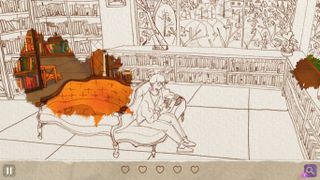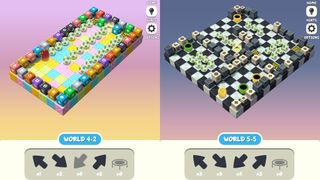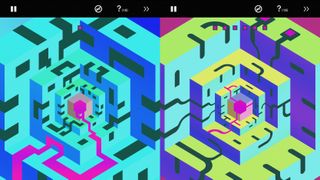The best free iPad games 2023
The best free games for iPad, iPad Pro, iPad Air and iPad mini
Our favorite free iPad logic tests, path-finding challenges, bridge builders, and turn-based puzzlers.

Otteretto
Why you can trust TechRadar
Otteretto is a puzzler based on palindromes. You drag out strings of colored squares that have the same pattern in both directions. The more complex the string, the more points you get. High scores are vital, because each level demands you net a particular tally.
The game started life in the browser, and the iPad’s main mode is identical. Fortunately, the original was fantastic, and that remains so here. But on iPad you also get a daily stack that pits you against the rest of the world with the same starting set-up.
Generously, there are no ads nor in-game currencies. The sole IAP is a very reasonable $2.99/£2.49/AU$4.49 that unlocks three variants: Puzzle; the Tetris-like Containment that adds more squares after each move; and Walls. But even the classic mode will keep you occupied for weeks.

Love is… in small things
Love is… in small things tells the story of two people falling in love, across a series of charming hand-drawn images and a simple, sweet-natured narrative. Propelling this story is a layer of hidden object puzzling.
Each scene starts off resembling a pencil sketch. A selection of items sits beneath this scene, and they are also hidden within the illustration. When each one is tapped, a little explosion of color is emitted from beneath your fingertip. Once you’ve found all of the objects, the entire image will be flooded with painterly hues and the story will continue.
It’s all very simple – almost meditative. But when you’re in the mood for lean-back stress-free entertainment, this really is a game where you’ll find that love is in small things.

Dungeons of Dreadrock
Dungeons of Dreadrock is a real-time puzzle game that subverts expectations. After a quick scene-setting intro – a sibling kidnapped; the hero resolving to rescue them – you enter a dank tile-based dungeon, and must figure out how to reach the exit. Doing so across the first few screens is simple enough, in a game that feels fun – if a bit ordinary.
Soon, though, you evade a huge troll, who then chases you to the next single-screen challenge. You immediately realize Dreadrock wants you to think on your feet, adding tension to what could have otherwise been a thoughtful but somewhat pedestrian game.
Such surprises and changes in pace continue throughout. And on the iPad in particular, wonderful visuals, packed with character, further elevate what was already a miniature masterpiece of mobile game design.

Nora’s Dream
Nora’s Dream is a puzzle adventure that finds the protagonist in a mysterious world, inhabited by creatures that claim to know her. But she has no recollection of how she came to be there – nor what she should do next.
In effect, this is a room escape game. You’ll chance across puzzles: arcane symbols that need deciphering; creatures that demand an item for you to progress. Through careful observation of your surroundings, you’ll –eventually – crack the code.
The sense of openness sets Nora’s Dream apart, though. Instead of the claustrophobia and tension commonplace in this sub-genre, there’s an air of freedom. And while the laid-back pace and regular backtracking can sometimes irk, Nora’s Dream is an excellent download for anyone who prefers their puzzlers to be exploratory and yet composed in nature.

Linia super
Linia super sits part-way between methodical swordplay and observational puzzler. It takes place in a world of abstract, geometric, animated artworks. Shapes and objects shift and twirl in a regular and repeating pattern, which when combined with the chill-out soundtrack makes for a relaxing and almost hypnotic experience.
A sharp sense of precision and study is required for what comes next, though, with you aiming to match a sequence of colored dots by dragging a line through the on-screen shapes. Get it right and you move on to the next level in the sequence. Get it wrong and you end up in an increasingly tense situation, trying to get past the current challenge with a diminishing reserve of virtual ‘ink’.
It’s great stuff, whether you’re in it for the tension, the imaginative design, the art, or all of these things.

Sugar (game)
Sugar (game) is, yes, a game about sugar. More specifically, it’s about directing huge grains of sugar that pour from a spout into cups placed on the screen. This is achieved by you drawing guides for the sugar to move along. Easy!
Well, it is at first. But Sugar quickly puts your ego in check. It first demands you fill two cups rather than one. Then you’ll find screens that wrap around from bottom to top, inconveniently require you to switch gravity, and have sugar-coloring gates.
Since everything happens in real-time and you cannot delete any path you draw, you have to have your wits about you – even when you’ve got a pretty good idea about how to beat a level. In all, this is a tactile and very sweet puzzler.

Kitty Q
Kitty Q kicks off with a literal take on Schrödinger’s cat landing on your doorstep. This horrifying and yet endearing moggie is half alive, half dead, and you’ve been tasked with taking care of it while exploring quantum physics. What this involves in gameplay terms is a science-infused room escape title, where you find clues, solve puzzles, and tickle the cat’s belly so it will regurgitate the objects you need to continue.
For a game digging into deep subject matter, Kitty Q is a breezy and cheerful affair. The visuals are bright and look wonderful on the iPad’s large display. At any point, Schrödinger’s (fictional) great-granddaughter is on hand to offer tips, and there’s even an in-game phone with a Kittypedia app that will merrily smash out your brains with science facts if the game’s puzzles fail to do so first.

Puzzle Dino - Egg Adventure
Puzzle Dino - Egg Adventure features a stompy dinosaur with a thing for eggs. In each single-screen level, you place a limited number of directional arrows and other objects. Hit play and the prehistoric protagonist will scoot along, as directed by the tiles. Get things right and they’ll reach the exit. If not, you’ll need to try again.
If you’ve been around the gaming block a few times, you’ll recognize echoes of Dreamcast classic ChuChu Rocket, but Puzzle Dino is rather more thoughtful and sedate, with its single creature to direct (versus the dozens in ChuChu Rocket). Fortunately, the effect is more relaxing than ponderous, with Puzzle Dino adding a hints system to help you along if you get stuck. Add lush visuals and you’ve got a very smart freebie iPad puzzler.

Tile Snap
Tile Snap is a match game. But unlike in Bejeweled, matched elements are never replaced. Each level is therefore a puzzle, to be completed in a strict order, working your brain rather than only your swiping digit.
Said levels are constructed from tiles that pleasingly flip when dragged. This will be familiar to players of Dissembler (by the same creator) – although that app’s austere minimalism has in Tile Snap seemingly been replaced by vibrant digital takes on 1970s wallpaper.
What’s most surprising about Tile Snap, though, is its generosity. This is a premium experience, with beautifully responsive, tactile controls, and cleverly designed, hand-crafted levels. Yet there are no ads, and IAPs only exist for optional hints. So grab it now – and if you like it, buy one of the creator’s other games as a thank-you.

Dream Detective
Dream Detective is all about hidden objects. You’re presented with an animated illustration and a set of items to find, and must scroll about the screen and tap objects accordingly. This often plays out against the clock, and errant presses are punished, so you can’t just poke the screen with merry abandon.
Underpinning Dream Detective is quite a lot of complexity in terms of its interface and IAP. But do your best to ignore all that and you’ll find an entertaining, interesting example of this kind of game. The scenes are varied, with early examples including riffs on famous movies, and comic book pages.
The game might lack the elegance and chill-out vibe of the likes of Hidden Folks, but as a free alternative with time-based incentives, it’s a decent download – especially when you play on the iPad’s large display.

Kubrix
Kubrix sits part way between puzzler, meditative experience, and plain weird. First, the puzzling: this involves linking the center of the puzzle to square nodes, often (although not always) situated towards its edges. To achieve your goal, you rotate patterned sections of the puzzle, aiming to create unbroken pathways.
The meditative side comes from is free iPad game’s zero-stress nature. It’s the sort of thing you can play in a state of zoned-out bliss, working your way to a solution by fiddling around with what’s in front of you.
What really sells the game is its strange presentation. The center of the puzzle creepily beats like a heart, and other sound effects include mechanical scrapes and gruesome squelches. You work through each level feeling like you’re manipulating a techno-organic construct – some kind of living being, even if Kubrix is of course never anything other than abstract.

Total Party Kill
Total Party Kill upends any gaming conventions you’d expect when a heroic party enters a dungeon. Usually, each member would help the others survive. But here, the knight, mage, and ranger use their powers to ‘sacrifice’ team-mates, and use their corpses as stepping stones to tricky-to-reach exits.
Early on, it’s simple enough to figure out what to do. But as you reach the later dungeons, figuring out the precise order in which to dispatch your colleagues – and precisely how to do so – can be a serious challenge.
The black humor is appealing, as your ranger leaps on a cross-eyed mage pinned to the wall, before doing a little dance on reaching the exit. But the mechanic also freshens up what could otherwise have just been yet another entry in the single-screen puzzler sub-genre.

Sky: Children of the Light
Sky: Children of the Light is a multiplayer online adventure. Created by the brains behind console classic Journey, Sky is a visually dazzling game, which often finds your winged protagonist gliding above lush landscapes and skidding down hillsides.
Your aim is to spread hope through a kingdom by returning fallen stars to the skies. This means plenty of exploration to find objects that unlock further progress. Most puzzles barring your way are quite simple, but they often require the help of friends – temporary or permanent – you can make in-game.
From the eye-popping visuals to the smartly conceived social interactions, Sky is a must-install. There are odd moments of frustration, but these are easily forgotten when you’re reveling in the experience, lost to one of the most beautiful game worlds imaginable.
Current page: The best free puzzle games for iPad
Prev Page The best free platform games for iPad Next Page The best free racing games for iPadGet daily insight, inspiration and deals in your inbox
Get the hottest deals available in your inbox plus news, reviews, opinion, analysis and more from the TechRadar team.
